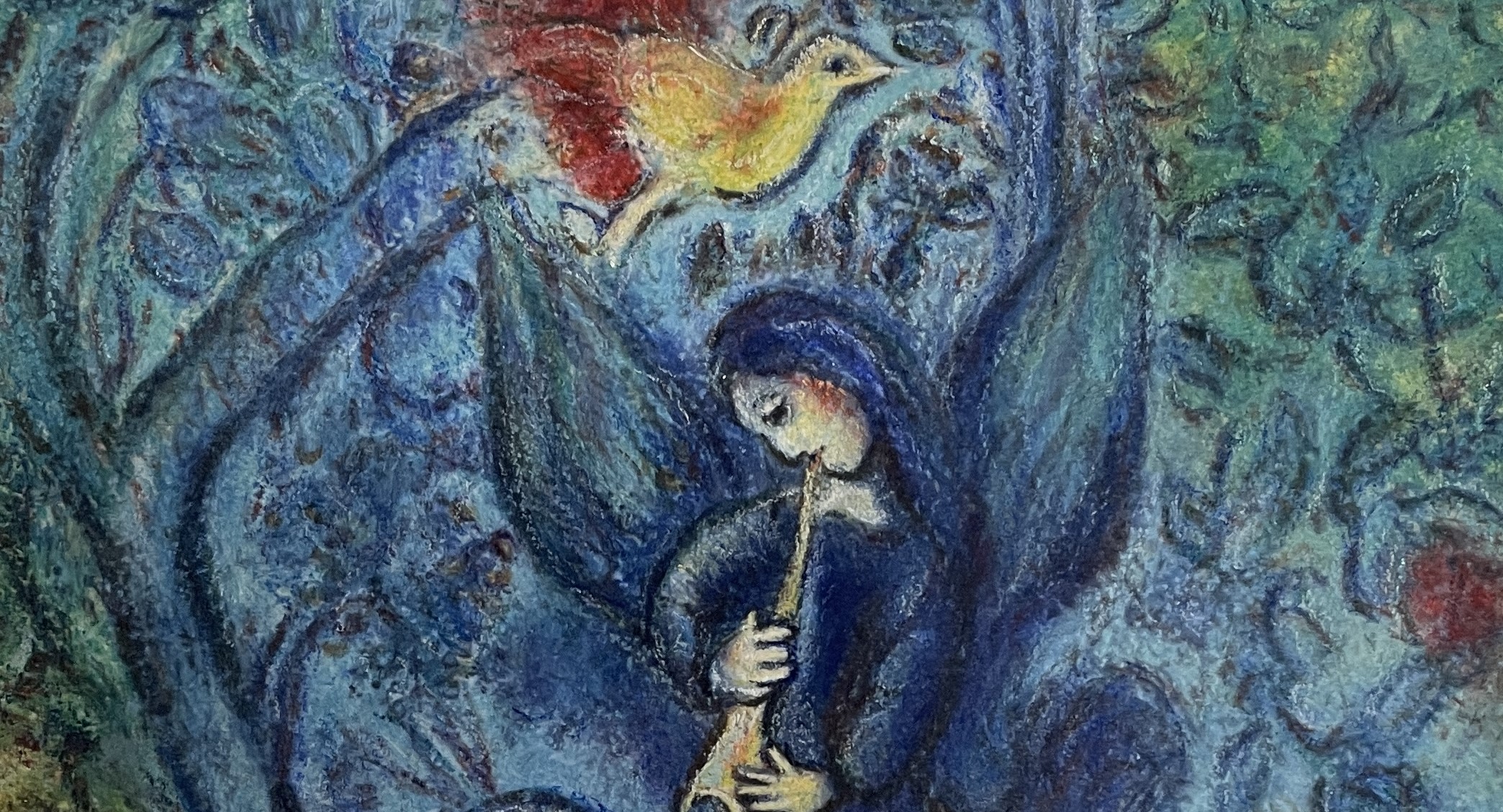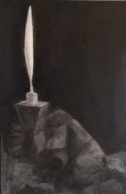日本語-Englishー台灣華語
コンスタンチン・ブランクーシ「ブランクーシの肖像」
時々彫刻家の気持ちを理解しようと思って、彫刻を絵に描いてみる。「ブランクーシの肖像」は、ブランクーシ自身が撮ったアトリエの写真をもとに描いたものだ。ブランクーシは他人が自作を撮影することを滅多に許可しなかった。彫刻作品が如何に見られるべきであるかは、作家自らが示すべきものと考えていたからだ。ロダンも制作過程の写真に彩色して表現の可能性を探っているが、ブランクーシにおいて写真と彫刻作品はより密接に関わっている。ブランクーシの写真はマン・レイが指摘しているように写真としては露出過度で、ピントが微妙に合っていない。研磨されたブロンズ作品には光が強く反射し、輪郭がはっきりしない。しかし作者であるブランクーシ自身は、彫刻の真意が表現されている自らの写真の方を良しとした。
グループ・モビールと呼ばれる複数の作品を意図的にグルーピングした写真や、アトリエの中に特定の作品を配置し、彫刻間の結び付きを表現した写真を制作している。アトリエ全体の写真は、ブランクーシにとっては完成した彫刻作品を写し出すための手段であることを越え、より深い意味を担っている。苦悩の全過程を知るアトリエは、ブランクーシにとっては聖なる生誕の場であり、そこで生み出された作品が共存する場でもある。
写真はブランクーシにとって直彫りの困難を解決する手段でもある。ロダンと訣別して以降、ブランクーシはロダンのモデリング手法への反発から主に石材や木材を直彫りする。彼は写真を頼りに石や木にノミを入れ直した。ブランクーシの彫刻にはたがねの跡が不規則に残っている。それが鋳造されたものではなく、手で彫刻されたことをはっきりと刻印している。 アトリエの写真には、ブランクーシの最も優れた作品であると私が思う「鳥」が写っている。かつて金属片としてしか米国に入管できなかったブランクーシの鳥は、もはや手が届かない位高価になってしまった。ブランクーシのアトリエにある「鳥」には、それぞれにわずかな違いがある。相互の差はほとんど見分けられない場合もあるが、それぞれが新たな霊感の産物であり、別の鳥なのである。その一つ一つが、まるで足元にある様々な苦悩の集積から、不死鳥のように蘇ったブランクーシの魂のようだ。
ブランクーシは決して前衛的抽象彫刻家ではない。ブランクーシは言っている。「事物の本質に接近して行くと、知らず知らずのうちに単純さに到達する。単純さはその根底に複雑さを秘めている。」と。ブランクーシは決して抽象を求めているのではない。それがいかに抽象的な性格を持っていようとも、彼にとっては極めてリアルなのだ。ブランクーシは「女とは何者であるか」と問う。永遠に女性的なものを求め「女」を作る。「女」はこの世のありとあらゆる女の姿をひとつの原型に要約しようとして生み出されたものなのである。ブランクーシは形態の探究を通じて、事物の本質を掴み取ろうとしたのである。
ブランクーシの彫刻では台座が重要である。台座のみを並べて彫刻作品と同じように撮った写真がある位だ。作品の台座だけを取り替えて撮影し、上下のバランスや効果を比較するような実験的な意味合いを持つ写真もある。彼の彫刻は大概古材でざっくりと切り出された台座に乗っている。それはまるで原材から研ぎ澄まされた彫刻が生まれ出たことを暗示するかのようだ。
アトリエは芸術家の創造世界をまるごと体現している。ジャコメッティは死ぬまで同じ小さなアトリエで制作をしていた。フランシス・ベーコンは混沌とした狭いアトリエに固執し、アトリエの大きさに合わせて絵の大きさを制限していた。ブランクーシのアトリエを描いたこの絵では、ブランクーシの彫刻にはあえて何も着色せずに紙のまま残し、苦悩の痕跡を示す彫刻の断片は黒い鉛筆で描くことにした。鳥の彫刻は白い光を放ち、その絵はまるでブランクーシの肖像のように思えてくる。
Studio of Brancusi
Sometimes I try to understand the feelings of a sculptor by drawing sculptures. “Portrait of Brancusi” is based on a photograph of the studio taken by Brancusi himself. Brancusi rarely allowed others to photograph his work. He believed that how a sculpture should be seen ought to be demonstrated by the creator himself. While Rodin also explored the possibilities of expression by coloring photographs of the production process, in Brancusi’s case, photography and sculpture are more closely related. As Man Ray has pointed out, Brancusi’s photographs are overexposed and slightly out of focus. Light reflects strongly off polished bronze works, making their outlines unclear. However, Brancusi himself preferred his own photographs, in which he believed the true meaning of his sculptures was expressed. He produced photographs that intentionally grouped multiple works, called “Group Mobiles,” or placed specific works in the studio to express the connection between sculptures. Photos of the entire studio carry a deeper meaning for Brancusi, transcending the mere method of depicting finished sculptures. The studio, knowing the entire process of suffering, is for Brancusi a sacred place of birth and a space where the created works coexist. Photography also served as a means for Brancusi to solve the difficulties of direct carving. After breaking with Rodin, Brancusi mainly carved directly in stone or wood, rebelling against Rodin’s modeling techniques. He relied on photographs to directly chisel into stone or wood. The marks of the chisel irregularly remaining on Brancusi’s sculptures clearly imprint that they are not cast but hand carved.
The photo of the studio includes what I consider Brancusi’s finest piece, “Bird.” Brancusi’s bird, once only able to enter the United States as a metal piece, has now become prohibitively expensive. Each “Bird” in Brancusi’s studio has slight differences. While the differences between them are almost indistinguishable, each is the product of new inspiration, a different bird. Each one is like the soul of Brancusi, reborn like a phoenix from the accumulation of various sufferings at his feet.
Brancusi is not an avant-garde abstract sculptor. He says, “As you approach the essence of things, you unwittingly reach simplicity. Simplicity harbors complexity at its core.” Brancusi was not seeking abstraction. No matter how abstract in character, it was incredibly real to him. Brancusi asks, “What is a woman?” He sought the eternal feminine and created “Woman.” “Woman” is an attempt to summarize the appearance of all women in the world into one archetype. Through the exploration of form, Brancusi aimed to grasp the essence of things.
The pedestal is important in Brancusi’s sculptures. There are even photographs taken of just the pedestals, arranged as if they were sculptures themselves. There are photos with experimental implications, taking pictures of only the work’s pedestal, changing it, and comparing the balance and effect. His sculptures are generally mounted on roughly cut bases of old material, suggesting that the sculpture has been honed from the raw material. The studio embodies the entire creative world of the artist. Giacometti worked in the same small studio until his death. Francis Bacon clung to a chaotic, small studio, limiting the size of his paintings to fit the studio’s size. In this painting of Brancusi’s studio, I decided to leave Brancusi’s sculptures uncolored, retaining them on paper, and to draw fragments of sculptures indicating traces of suffering with a black pencil. The bird sculpture emits a white light, making the painting seem like a portrait of Brancusi himself.
康斯坦丁·布朗庫西《布朗庫西的肖像》
有時候,為了理解雕塑家的心情,我會嘗試將雕塑畫成畫作。《布朗庫西的肖像》是根據布朗庫西自己拍攝的工作室照片所畫的。布朗庫西很少允許他人拍攝自己的作品。他認為應該由藝術家自己展示作品應該如何被看待。羅丹也曾對製作過程中的照片進行著色,探索表達的可能性,但在布朗庫西那裡,照片和雕塑作品的聯繫更為密切。正如曼·雷指出的,布朗庫西的照片往往曝光過度,焦點略顯不清。拋光過的青銅作品反射出強烈的光芒,輪廓不太清晰。然而,作為作者的布朗庫西本人更喜歡自己的照片,認為它們表達了雕塑的真正意圖。他製作了一系列照片,這些照片將多件作品以意圖性的方式組合在一起,稱為群體移動,或在工作室內特意擺放特定的作品,以表達雕塑之間的聯繫。整個工作室的照片不僅僅是展示完成的雕塑作品的手段,對布朗庫西來說,它們承載了更深層的意義。對他而言,工作室是一個神聖的創作場所,其中孕育出的作品共存於此。照片對布朗庫西來說也是解決直接雕刻中遇到的困難的一種手段。自從與羅丹決裂後,布朗庫西主要通過直接在石頭或木頭上雕刻,反對羅丹的塑模方法。他依靠照片直接在石頭或木頭上進行雕刻。布朗庫西的雕塑上留有鑿子的痕跡,這些不規則的痕跡清晰地表明了這些作品是手工雕刻的,而不是鑄造的。
工作室的照片中展示了我認為是布朗庫西最優秀的作品之《鳥》。布朗庫西的《鳥》曾經只能作為金屬片進入美國,現在已經變得高不可攀。工作室中的《鳥》各有細微的差異,雖然這些差異幾乎無法分辨,但每一件都是新靈感的產物,是不同的鳥。每一件都仿佛是布朗庫西的靈魂,從腳下的種種苦難中,如不死鳥般重生。
布朗庫西絕不是一位前衛的抽象雕塑家。布朗庫西說:“當接近事物的本質時,不知不覺中會達到簡單。簡單之下隱藏著複雜。”布朗庫西並非追求抽象;無論其作品多麼抽象,對他來說都是極其真實的。布朗庫西問道:“女人是什麼?”他永遠在尋找女性的本質,創造“女人”。“女人”是將世上所有女性的形象總結為一個原型所創造出來的。布朗庫西通過對形態的探索,試圖把握事物的本質。
對於布朗庫西的雕塑來說,底座非常重要。有的照片僅展示了排列如同雕塑作品一般的底座。還有一些照片以實驗性的方式拍攝了僅更換底座的作品,比較了上下平衡和效果。他的雕塑大多安放在粗糙切割的古材底座上,彷彿這些底座暗示了從原材料中精雕細琢出雕塑的過程。工作室是藝術家創造世界的全面體現。像賈科梅蒂一樣,直到去世都在同一個小工作室中創作。弗朗西斯·培根堅持在一個混亂狹小的工作室中工作,並根據工作室的大小限制畫作的尺寸。在畫布朗庫西的工作室的這幅畫中,我決定不對布朗庫西的雕塑進行任何著色,保留紙本原貌,而將表達苦難痕跡的雕塑片段用黑色鉛筆畫出。鳥的雕塑散發出白色的光芒,這幅畫似乎就是布朗庫西的肖像。


